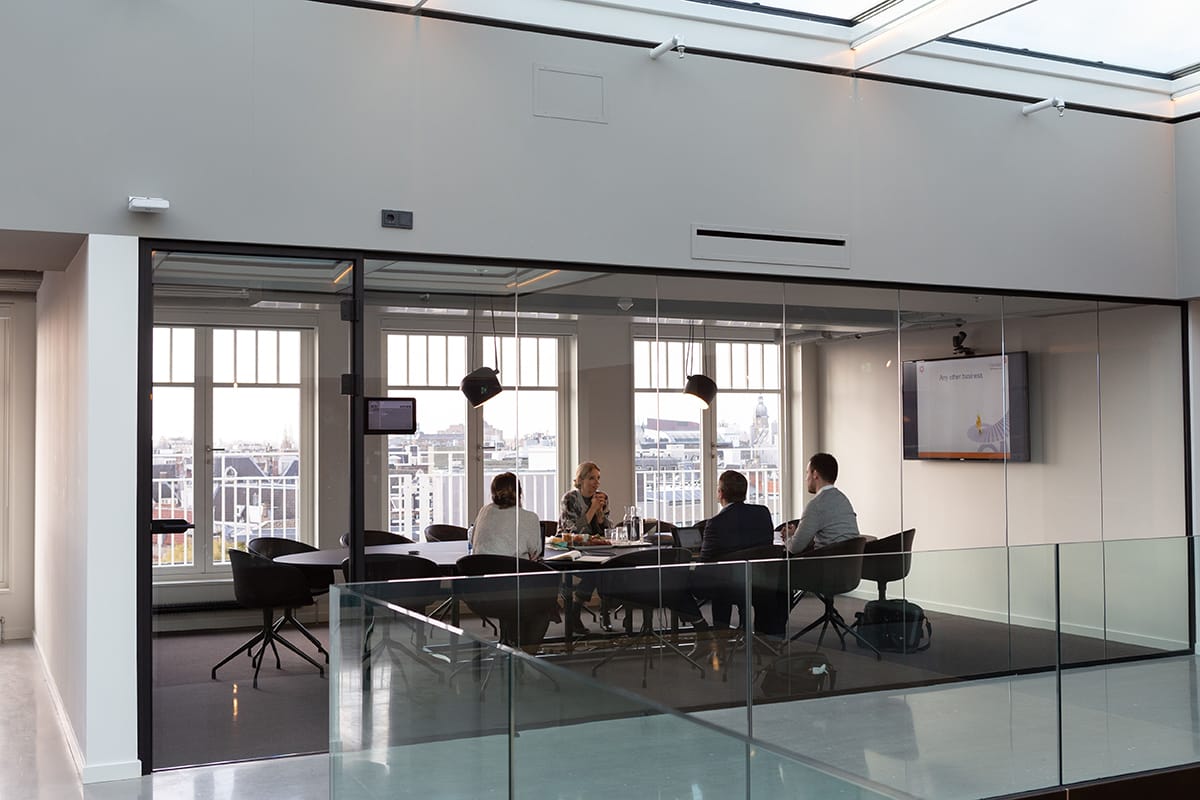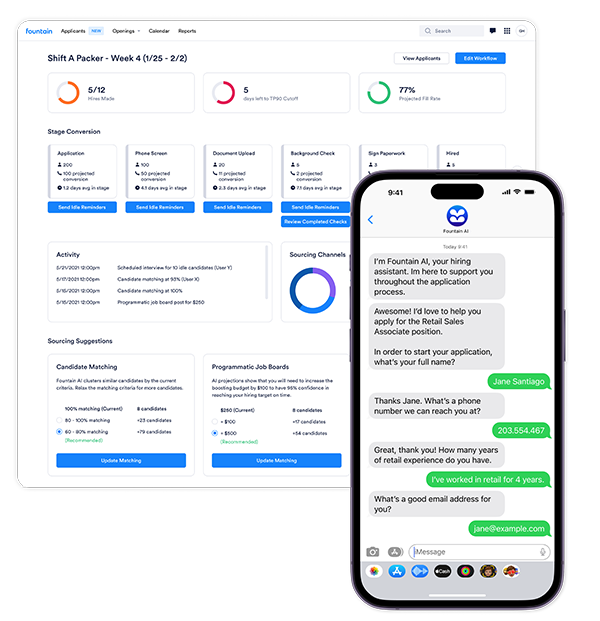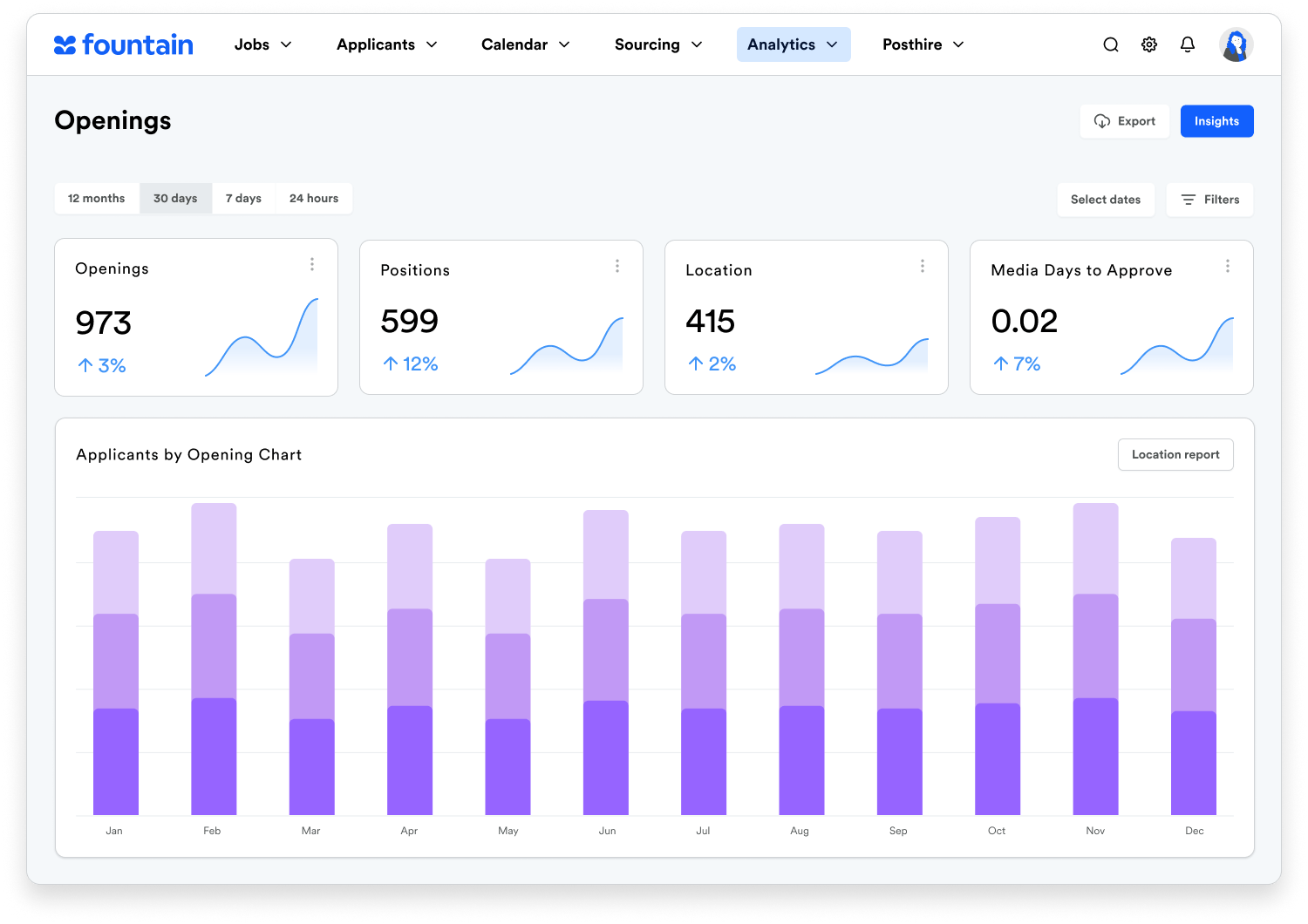We had the pleasure of speaking with Christa Stienen, former CHRO of DB Schenker Germany/Switzerland and Hellmann and current Fountain Advisor, about hourly hiring in Germany and the challenges businesses face in today’s hiring market.
Fountain: Hi Christa, thank you for meeting with us today. Over the course of your career, you’ve occupied a number of positions—from HR Business Partner to Head of Human Resources International to Chief People Manager, just to name a few—across well-known corporations and industry verticals. Given your vast experience in People Management and HR, how would you describe hourly hiring in Germany today? What are the challenges?
Companies in Germany are facing a number of unexpected circumstances—the war in Ukraine, the pandemic, the energy crisis, the worker shortage, and more. They are all challenges that require today’s businesses to rethink how they operate and hire and adapt to these unforeseen circumstances. Unfortunately, despite these external market pressures,
“HR leaders [in Germany] aren’t moving with the necessary urgency. In fact, they are in a state of shock paralysis.”
Fountain: What does a “state of shock paralysis” look like in a business and how should business leaders go about addressing it?
The most common sign of a business being in a state of paralysis is when you start to see a lot of busy work being done that is very reactive. It is when leaders start to micro-manage and even step outside of their designated roles and act without a clear strategic plan and direction. It’s the do-more-of-the-same trap that people tend to fall into when trying to address unforeseen challenges. These are all clear signs that a business and its people are struggling to adapt, and are trying to operate as usual and hold on to what they know, despite realizing that they need to change. One such example is the topic around remote work and how some businesses are still struggling to adapt to the lack of control of not having their employees in the office. As a result, they’re demanding their employees to return full-time to the office because they believe that’s the only way to be effective.

What businesses need to do instead is create a strategic management team, consisting of all the right stakeholders, not just HR, to assess their current situation, determine what their people and business truly need to be effective, and define a clear plan that aligns all parties to move the business forward effectively and efficiently.
Fountain: You touched upon how leaders recognize the need for change but refuse to actually adapt. What is preventing them from adapting? What are some of the roadblocks?
There are a number of reasons why management might be resistant to change. For example, the preference to turn a blind eye to the problem and a lack of willingness to actually confront and address the issue. Unavailable budget and limited resources are other common excuses.
As HR professionals, we also need to understand that during times of crisis, employees might not want to take risks. If a business doesn’t have a culture that embraces change, fosters collaboration, and rewards people for speaking up, chances are that employees will try to avoid drawing too much attention to themselves in times of change out of fear for their job. It takes courage to push for change, and if a business hasn’t built the necessary safe environment to support those individuals, then change will be hard to manifest when it is needed most.
Fountain: Why do you think business leaders shy away from change?
Change is hard and is often tied to risk. It is uncomfortable, and even though leaders recognize the need for it, they don’t act on it because of fear. Instead, companies recruit Change Managers to take on that responsibility with limited success, as it takes more than just two or three people to be the champions of change. It takes all stakeholders to have a clearly defined strategy and plan. What tends to happen, though, is that what should be a significant transformation led by the leadership team ends up being minor, tactical changes that are relegated to a handful of employees while everyone else sticks to the processes and roles they have become accustomed to.

Fountain: What would you say to those HR employees and leaders who seek to drive change within their organization but are dealing with this sort-of paralysis in their organization?
Find like-minded people within your organization who are looking to move and drive change, not only in HR but across the organization. Identify the areas in which you can and should make an impact as an HR professional. Have the courage to speak up when you see that something isn’t working, and seek dialogue with others to include different perspectives and opinions.
When you start to include the input of others and bring them along, the change journey no longer is as frightening as it was when you first started.
Fountain: What are some specific skill sets needed to become a successful HR professional who is adept at dealing with change?
As I said, change is a team sport; you can’t do it alone. You need curiosity, the will to question things and not settle, and the ability to build strong networks across the organization. Finally, you need the ability to always challenge yourself. It shouldn’t happen only once a year, during your annual performance review, for example.
You should have a continuous hunger for personal and professional growth. That’s how you become an agent for change. And one of the most important skills is positivity, humor, and being able to laugh at yourself and not take yourself so seriously.
Fountain: Sometimes, wanting to change things isn’t enough and there are significant obstacles that someone in HR needs to overcome. What are some of the structural barriers you see that are making it hard for HR professionals to be the change they seek?
Oftentimes, HR isn’t as financially supported as it should be, and instead is treated just as a department that takes care of everyday tasks, the payrolls, and employee complaints, and not as a possible source for change.
For example, everyone speaks of automation and digitalization. A lot of money is being invested in this space and you’re seeing operations and systems completely transformed because of it. But HR systems and their processes are, most times, the last beneficiaries of such change, even though this is a department that could significantly benefit from automation to speed up their processes, save valuable resources, and reduce human errors.
That is why I always recommend leadership teams pay close attention to the data and investigate where there are opportunities to improve existing processes, especially in HR.
Fountain: Speed and time-to-hire are particularly important for hourly hiring. What do business leaders need to recognize specifically when it comes to hourly workers, and why does “business as usual” no longer apply?
The pandemic has caused a seismic shift in power between applicants and employers. Those seeking hourly jobs are no longer required to take any job that comes their way. Due to the labor shortage, job seekers have the luxury of choice and will choose the company that shows them the attention and recognition they expect. This means applicants are applying to multiple jobs at the same time, all within minutes on their phone, and they will pick the opportunity that responds and gets them to work the quickest.
For example, Germany is currently hiring about 100,000 people in hospitality. We’re also experiencing a shortage of workers in healthcare. That’s why if a company does not answer an applicant during the first 24 to 48 hours, the applicant will find another job opportunity, no question about it.
In today’s labor shortage, businesses need to move with haste if they want to win.
Besides speed, it is also important for leadership teams to understand the workload and cost that goes into each hire, even for those hourly positions. For example, recruiters do a lot of administrative work, like scheduling and facilitating interviews with the hiring managers, dealing with candidates dropping off, etc., and that takes a lot of time—time they could be spending speaking with candidates and hiring the right talent faster. This is valuable time that can be saved with the right investments and recruiting tools. That’s why I like Fountain, because it automatically takes care of all these tasks in the background, freeing up recruiters’ time to focus on the things that matter most, and ultimately making the hiring process more cost-efficient and improving their employer branding.
Fountain: Employer branding is an interesting one. When do you think employer branding should start for an organization?
Right from the start. It all begins with the first applicant touch point. The applicant needs to feel they are not just a number and instead will be valued if they join the company. But once someone is recruited and put on the job, it’s important that their positive experience doesn’t stop there. It needs to carry through the entire employee journey with the organization. From the hiring process to onboarding, throughout their time at the company, and even their exit interview. Today, with social media, exiting employees can go online and provide ratings and write reviews instantaneously, and businesses need to recognize the opportunity and threat this poses to their brand.

The introduction of digitalized HR processes for onboarding and employee management along with automated employee servicing systems can go a long way in not only hiring a worker but also keeping them engaged and motivated during their time at the company.
Fountain: Last question. Often HR tends to use commonly used job boards to post their job openings and expects applicants to come to them. With all the changes in technology and the importance of social media, especially TikTok, what advice would you give HR teams when looking to reach workers today?
I would say to be exceptional in your hiring process and employer branding. Consider the generational differences of the workers you are looking to recruit, use the channels they frequently engage in, and try to personalize your messaging.
TikTok, for example, isn’t a channel I personally use, but it is a channel that the younger generation uses to communicate. If you’re trying to reach Gen Z workers, you have to use their channels and engage them where they are on the platforms they use most. This includes hiring hourly workers through WhatsApp or even SMS and conducting video interviews—all commonly used means of communication for today’s younger hourly worker.
About the Author

Christa Stienen has more than 10 years of experience as a Chief People Officer, SVP of Human Resources, Head of HR, and similar roles. She currently serves as an Advisor on multiple Executive and Advisory Boards, including Fountain’s Advisory Board.

